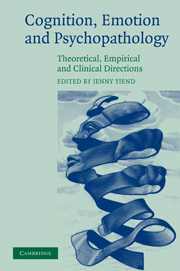Book contents
- Frontmatter
- Contents
- List of contributors
- An introduction and synthesis
- Andrew Mathews: a brief history of a clinical scientist
- Part I Theoretical approaches
- 1 The positive and negative consequences of worry in the aetiology of generalized anxiety disorder: a learning theory perspective
- 2 Trait anxiety, repressors and cognitive biases
- 3 A cognitive-motivational perspective on the processing of threat information and anxiety
- 4 Maintenance or capture of attention in anxiety-related biases?
- Part II Empirical directions
- Part III Clinical perspectives
- Index
2 - Trait anxiety, repressors and cognitive biases
Published online by Cambridge University Press: 23 November 2009
- Frontmatter
- Contents
- List of contributors
- An introduction and synthesis
- Andrew Mathews: a brief history of a clinical scientist
- Part I Theoretical approaches
- 1 The positive and negative consequences of worry in the aetiology of generalized anxiety disorder: a learning theory perspective
- 2 Trait anxiety, repressors and cognitive biases
- 3 A cognitive-motivational perspective on the processing of threat information and anxiety
- 4 Maintenance or capture of attention in anxiety-related biases?
- Part II Empirical directions
- Part III Clinical perspectives
- Index
Summary
Introduction
The main emphasis of this chapter is on the personality dimension of trait anxiety, which is concerned with individual differences in the tendency to experience anxiety and related negative emotional states. There is general agreement among personality researchers and theorists that trait anxiety (or neuroticism) is one of the most important personality dimensions. Most researchers focusing on the structure of human personality (e.g. McCrae & Costa, 1985) accept there are five main personality dimensions or factors (often called the Big Five), of which neuroticism or trait anxiety is one. Thus, there is considerable consensus at the level of description. Note that the terms ‘trait anxiety’ and ‘neuroticism’ will be used more or less interchangeably in what follows. This is justifiable for two reasons. First, the two personality dimensions typically correlate about +0.7 with each other (H. J. Eysenck & Eysenck, 1985; the name ‘Eysenck’ on its own refers to the author of this chapter). Second, there is considerable evidence that trait anxiety and neuroticism are both relatively pure measures of a broad personality dimension known as negative affectivity (Watson & Clark, 1984). However, it should be noted that neuroticism is typically orthogonal to the personality dimension of extraversion, whereas there is a small negative correlation between trait anxiety and extraversion (H. J. Eysenck & Eysenck, 1985).
There has been significantly less progress at the level of explanation than at the level of description. In other words, the nature of the mechanisms underlying individual differences in trait anxiety or neuroticism remain unclear. Some of the main theoretical approaches are discussed in this section. Thereafter, the emphasis will be on a theory of trait anxiety proposed by Eysenck (1997).
- Type
- Chapter
- Information
- Cognition, Emotion and PsychopathologyTheoretical, Empirical and Clinical Directions, pp. 49 - 67Publisher: Cambridge University PressPrint publication year: 2004
- 3
- Cited by



